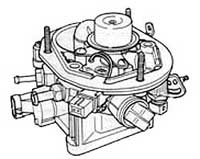
2.2 & 2.5 EFI Natural Aspirated
overview
1) General breakdown by year-
1984-1985
The first two years of TBI FI used a single high pressure (36 psi) injector mounted in a throttle body, "slider" camshaft and fairly crude electronics. The 1984 year had oddball "stud" connectors for the coolant sensor which was done away with in 1985. 1985 introduced the GM style weatherpak connectors for the sensors which are still in use to this day. Logic modules & power modules between 84 and 85 are not interchangeable. Headbolt fastener size is 10 mm for the 84-85 model year.
1986-1988
1986 introduced the new low pressure (15 psi), low profile TBI FI setup.

The TBI unit received a major redesign to use the new injector for a number of reasons- It allowed for a lower hood line, incorporated a new 4 wire idle speed motor (AIS) for better idle control and TB temp sensor for detection of conditions which could cause vapor lock. Also introduced was the new "tall deck" 2.5 engine. It was 12 mm higher then the 2.2 and would have been impossible to use in a lot of cars with the old injection system. Also changed in 1986 was the distributor to a new wider, shorter unit which is electrically incompatible with the 84-85 electronics. 1986 also introduced the "fast burn swirl head" on the TBI and Turbo applications. Better throttle response and a decrease in spark knock were the claimed benefits. Headbolt diameter is increased to 11 mm. In 1988 the 2.5 engine received a roller camshaft and round tooth timing belt setup with an unique cam sprocket. The 2.2 did not receive a roller cam and round tooth belt till march of 88. All 2.5 were equipped with balance shafts to reduce "shake" at idle. Weatherpak connectors were used on everything.
1989-1990
Biggest change in 1989 was the dropping of the "tall deck" 2.5 after a 3 year production run. In it's place was a common block engine that could be either a 2.2 or 2.5 based on which pistons and crank were used. The 2.5 still used a unique cam sprocket different then the 2.2 and also different then the 88 2.5 as well.
1991-1995
Fuel injection pressure was increased to 36 psi so a single fuel pump could be used for TBI, Turbo and V6 application. Sometime in this timeframe the TBI housing base changed and will not fit on the earlier intake manifolds.

In 1993 Chrysler introduced the Port Fuel Injected Flex Fuel 2.5 engine which was produced in limited numbers till 1995. Read about the unique FFV engines here.
Detailed overview-
1984 (2.2 only)
36 psi EFI with narrow distributor, 84 only logic module & power module
G casting open chamber cylinder head, 10 mm headbolts, slider cam
6 bolt crank, "heavy" rods, square tooth timing belt, odd coolant sensor
1985 (2.2 only)
36 psi EFI with narrow distributor, 85 only logic module & power module
G casting open chamber cylinder head, 10 mm headbolts, slider cam
6 bolt crank, "heavy" rods, square tooth timing belt, weatherpak coolant sensor
1986-1987 (2.2 & 2.5)
15 psi, low profile TBI system with 86-87 logic module and power module
Swirl "fast burn" cylinder head, 11 mm head bolts, slider cam, 87 3 wire O2
Pistons changed on 2.2 to match new swirl casting head
8 bolt crank, light rods, weatherpak connectors on everything, wide distributor
2.5 with unique crank, rods, pistons, block, timing belt, cam sprocket & balance shafts.
1988 (2.2 & 2.5)
SMEC computer and wiring, roller cam and round tooth belt for 2.5 and late 2.2
Last year of tall deck 2.5
1989-1995 (2.2 & 2.5)
New Common block 2.5- same rods & block as 2.2, larger crank snout
2.5 still equipped with balance shafts, unique crank and pistons
89 SMEC electronics and 4 wire O2, 90-up SBEC electronics and wiring
2.2 only used in Sundance/Shadow after 91
PFI Flex Fuel 2.5 1993-1995
There were numerous small changes made over the years, this is a list of only the major highlights.